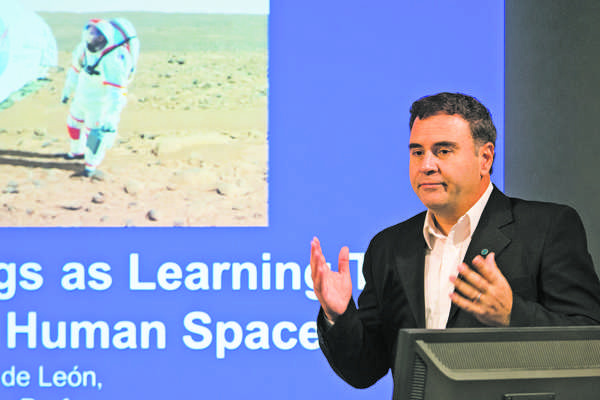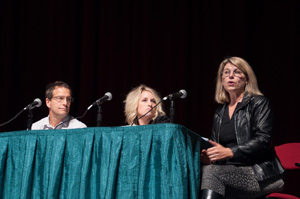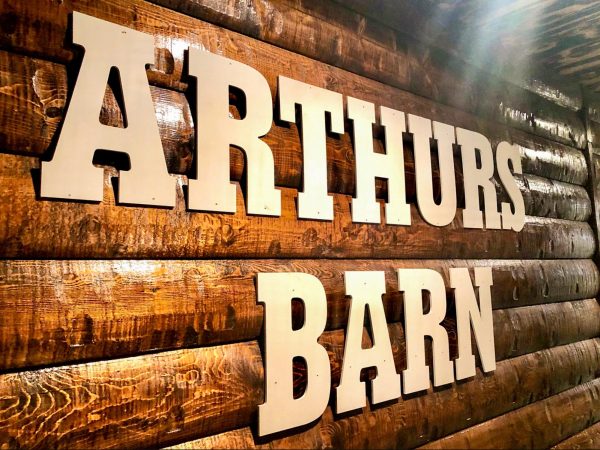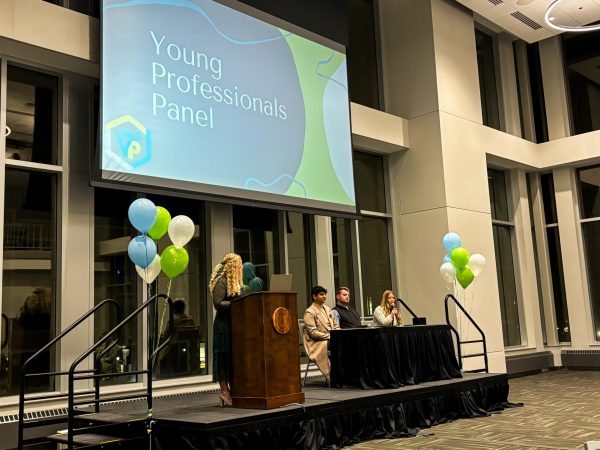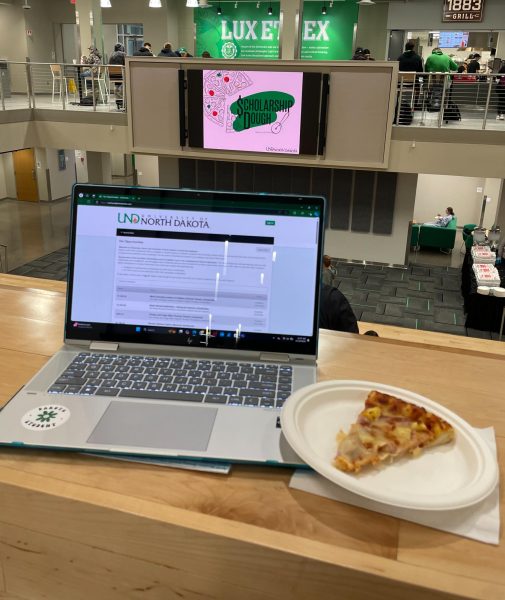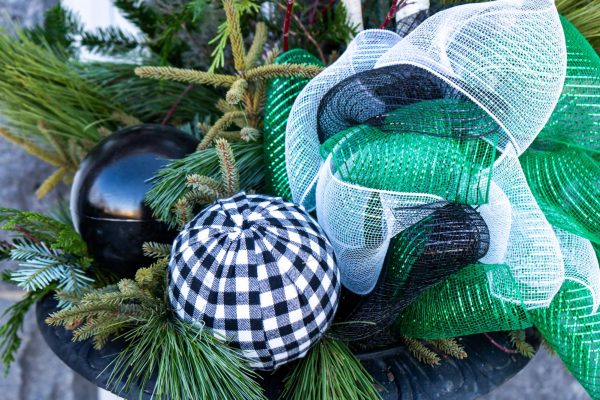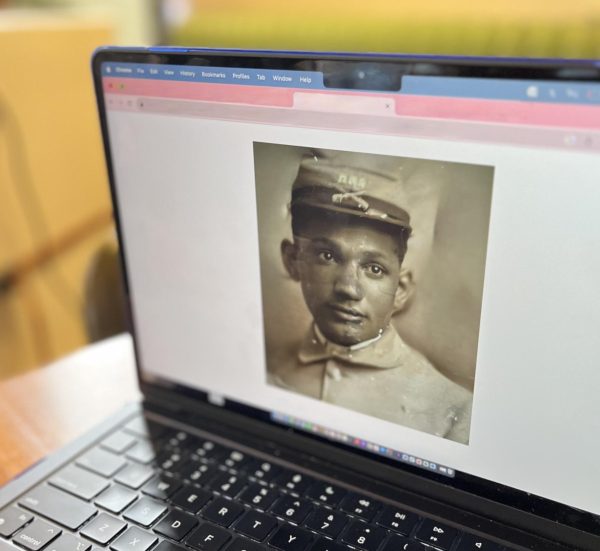UND Space Studies Series blasts off
Dr. Pablo de León presented to UND students, faculty and staff on his work on analog sites this Monday. Photo by Nick Nelson/The Dakota Student
This past Monday graduate students and space enthusiasts alike gathered in Ryan Hall for the first of seven total lectures in the UND Space Studies Colloquium Series.
The focus of the series is on human space exploration research for long-duration missions and will feature several leading experts in the field, the first of which was Pablo de León.
As an aerospace engineer for almost two decades, de León has experience in space project management, space suit design and extra-vehicular activities (EVA). He is currently an associate professor specializing in extravehicular activities and space suit design at the UND Department of Space Studies.
He is also preparing a new course on Human Spaceflight for UND and working as project manager of a NASA-funded program on planetary space suit design.
Working the space field for almost two decades, de León has an international reputation for his work on analogs. Analog sites are places with conditions that make them similar in some way to the conditions of a celestial body.
These sites portray simulations of various scenarios of how conditions would be on a space mission, including being enclosed in a small environment, or practicing a task the astronauts must complete in space. They also help figure out what can be done by humans and what can be done by robots instead while in space.
“Analog studies are important because they help test and simulate procedures and equipment which may be used in part to get to other planets or the moon. It also allows us to test techniques or conducting scientific research in space,” Dr. de León said. “Simulating space explorations on analog environments on earth reduces the risk and cost of future space missions.”
But the task of building an analog site is not as simple as it may sound. Dr. de León stressed the importance of fidelity. Fidelity describes how close the simulation is to the actual target environment in space. Conditions like reduced gravity and extreme temperatures can sometimes be difficult to simulate.
Specifically, Dr. de León’s lecture discussed research on analogs for Mars.
Mars has been a topic of interest for both NASA and other space organizations for quite some time. People can sign up with the Netherlands company Mars One to train to take a one-way trip to Mars and build a human settlement. Mars One expects to send an unmanned space craft in 2020, and crews will depart on the one-way journey starting in 2026.
Normally, analogs are crewed by teams of volunteers who operate under “Mars conditions” for a periods of time ranging from a few days to a few years.
Analogs can often be located in remote areas like Antarctica, deserts, or on the rugby field right here in Grand Forks, which is where the UND Space Studies Program analog site is tested.
Although being located in Grand Forks has some advantages, such as the extreme temperatures, it is still not an ideal location for the analog. This is why even though it is very expensive, the analog is built to be relocatable in case the opportunity arises to test elsewhere in different conditions.
UND currently is receiving an EPSCoR grant from NASA to increase current size and volume capabilities of the current analog unit. Dr. de León is hoping to add four modules to the current analog site with this grant, which will include modules for exercise, plant research, geology and EVA/maintenance.
There is another analog mission planned for April 2016 right here at UND because they help test and simulate procedures and equipment which may be used in part to get to other planets or the moon. It also allows us to test techniques or conducting scientific research in space,” de León said. “Simulating space explorations on analog environments on earth reduces the risk and cost of future space missions.”
But the task of building an analog site is not as simple as it may sound. As de León stressed the importance of fidelity. Fidelity describes how close the simulation is to the actual target environment in space. Conditions such as reduced gravity and extreme temperatures can sometimes be difficult to simulate.
Specifically, de León’s lecture discussed research on analogs for Mars.
Mars has been a topic of interest for both NASA and other space organizations for quite some time. People can sign up with the Netherlands company Mars One to train to take a one-way trip to Mars and build a human settlement. Mars One expects to send an unmanned spacecraft in 2020, and crews will depart on the one-way journey starting in 2026.
Normally, analogs are crewed by teams of volunteers who operate under “Mars conditions” for a periods of time ranging from a few days to a few years.
Analogs can often be located in remote areas like Antarctica, deserts or on the rugby field right here in Grand Forks, which is where the UND Space Studies Program analog site is tested.
Although being located in Grand Forks has some advantages, such as the extreme temperatures, it is still not an ideal location for the analog. Even though it is very expensive, the analog is built to be relocatable in case the opportunity arises to test elsewhere in different conditions.
UND currently is receiving an EPSCoR grant from NASA to increase current size and volume capabilities of the current analog unit, and de León is hoping to add four modules to the current analog site with this grant, which will include modules for exercise, plant research, geology and EVA/maintenance.
There is another analog mission planned for April 2016 right here at UND.
Journey Gontjes is a staff writer for The Dakota Student. She can be reached at [email protected]


